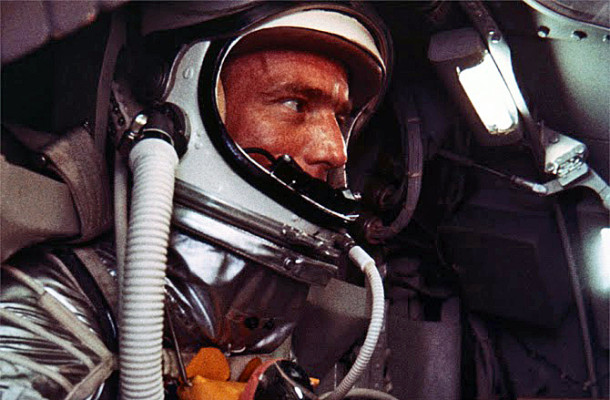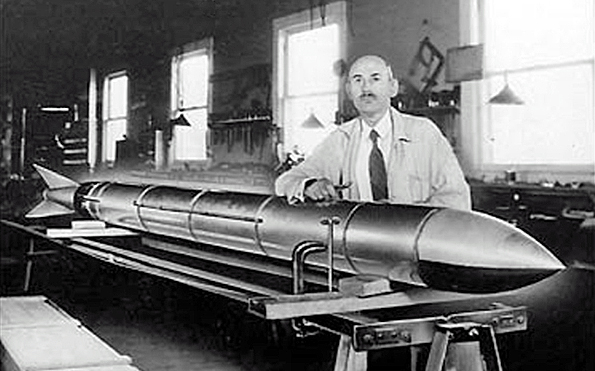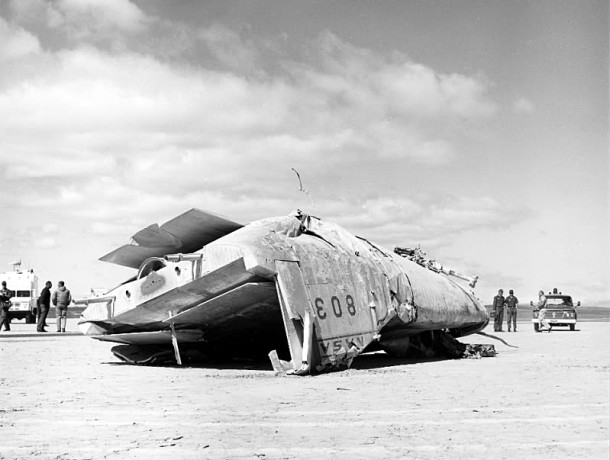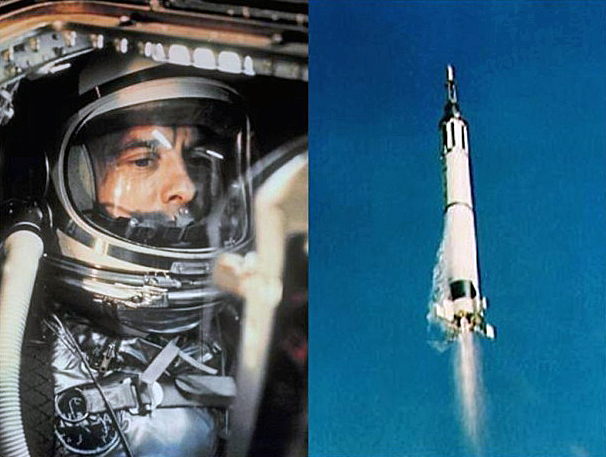
Fifty-three years ago this month, Mercury Astronaut M. Scott Carpenter orbited the Earth three times aboard his Aurora 7 Mercury spacecraft. In doing so, Carpenter became the second American to reach Earth orbit.
Project Mercury was America’s first manned spaceflight program. A total of six (6) flights took place between May of 1961 and May of 1963. The first two (2) flights were suborbital missions while the remainder achieved low Earth orbits. In February of 1962, John H. Glenn, Jr. became the first American to orbit the Earth during the Mercury-Atlas 6 (MA-6) mission.
Deke Slayton was to fly the Mercury-Atlas 7 (MA-7) mission. However, before that happened, the dreaded flight surgeon cabal grounded Slayton for what they deemed was a heart murmur. Despite Slayton’s utter incredulity and vehement protests, the decision held. Project Mercury officials maintained that the space program could ill afford the negative political fallout occasioned by the death of an astronaut on-orbit.
With Slayton grounded indefinitely, NASA selected Malcom Scott Carpenter to pilot the Mercury-Atlas 7 mission. Carpenter was member of the Original Seven selected by NASA for the Mercury Program in 1959. He was well prepared for the flight since he had just trained as Glenn’s MA-6 backup. As was the practice at that time, Carpenter named his Mercury spacecraft. The appellation he gave his celestial chariot was Aurora 7.
The launch of MA-7 took place on Thursday, 24 May 1962 from LC-14 at Cape Canaveral, Florida. Lift-off time was 12:45:16 UTC. Ascent performance of the stage-and-a-half Atlas D booster was nearly flawless as it inserted Aurora 7 into a 140-nm x 83-nm elliptical orbit. Having been cleared for at least 3 orbits, Carpenter quickly got down to the business of spaceflight.
Much of the activity on the first and second orbits involved Carpenter maneuvering his spacecraft, conducting scientific experiments and observing the Earth from space. Among other discoveries, he discerned that John Glenn’s mysterious “fireflies” were simply particles of ice and frost that had accumulated on the shadow side of the spacecraft. When the spacecraft structure was bumped or vibrated, these particles would disperse from the external surface of the spacecraft and float away into space. Once in the presence of strong sunlight, the particles appeared to glow or be luminescent.
A combination of the astronaut’s spacecraft maneuvering and an intermittently malfunctioning pitch horizon scanner left Carpenter with less than half of his maneuvering fuel left at the start of the third and final orbit. Carpenter compensated admirably by barely using his thrusters during Orbit 3. Indeed, nearing the time of retro-fire, Aurora 7 still had 40 percent of his fuel remaining in both the manual and automatic flight control systems.
As retro-fire approached, the intermittent pitch horizon scanner malfunction reappeared at a most inopportune moment. The automatic stabilization and control system suddenly would not hold Aurora 7 in the proper attitude for retro-fire; heatshield 34 degrees above the horizon at zero yaw angle. Carpenter subsequently switched to manual mode in an attempt to align the spacecraft properly for retro-fire.
When nominal time for retro-fire came, the retro-rockets did not automatically ignite. Carpenter had to do that manually. But he was 3 seconds late. Worst, Aurora 7 was still yawed 25 degree to the right. And to top it off, retro-thrust was 3 percent low. All of this meant that Aurora 7 would overshoot the nominal landing point by 215 nautical miles.
The trip down through the atmosphere was sporty in that Carpenter ran out of attitude control system fuel early during the descent. This meant that there was no means to propulsively damp the side-to-side oscillations that the Mercury spacecraft normally exhibited during reentry. These oscillations became dangerous when they exceeded about 10 degrees. That is, the spacecraft could tumble end-over-end if left unchecked.
Carpenter simultaneously eyed the altimeter and spacecraft angle-of-attack. As the latter built-up dangerously, his only recourse was to manually fire the drogue earlier than planned in attempt to arrest Aurora 7’s oscillatory motion. He did so at 25,000 feet. The spacecraft’s side-to-side oscillations were stopped. Carpenter then deployed his main parachute at 9,500 feet. Splashdown occurred at 17:41:21 UTC at a point 108 nautical miles northeast of Puerto Rico.
Since Aurora 7 was listing badly and help was about an hour away, Carpenter extricated himself from the spacecraft and deployed his life raft. While a radio beacon helped recovery forces locate him, there was no voice communication between the astronaut and his rescuers. Carpenter was on the surface of the briny deep nearly 3 hours before being picked-up by rescue helicopters and safely delivered to the carrier USS Intrepid. Some six (6) hours later, Aurora 7 was brought onboard the USS John R. Pierce.
Mercury-Atlas 7 was Scott Carpenter’s only space mission. A combination of factors, including less than amicable relations with Mercury Mission Control management, led to this being the case. During the intervening years, many stories alluding to pilot error or inattention as the cause of Aurora 7’s landing overshoot have been circulated. Indeed, much like Gus Grissom’s experience with the loss of his Liberty Bell spacecraft, these stories and explanations have been around long enough that they are now accepted as the “truth”.
Criticism of another’s performance comes easily in this world. However, as Theodore Roosevelt once pointed out, it really is “The Man in the Arena” who counts most. It is he and he alone who faces and reacts to the actual moment of trial. No one but he knows the utter reality of that moment and the vicissitudes thereof. While others may criticize, we go on record here to acknowledge and honor M. Scott Carpenter for his heroic and pioneering contributions to early American manned spaceflight.

Eighty years ago this month, pioneering rocket scientist Robert H. Goddard and staff fired a liquid-fueled rocket to a record altitude of 7,500 feet above ground level. The record-setting flight took place at Roswell, New Mexico.
Robert Hutchings Goddard was born in Worcester, Massachusetts on Thursday, 05 October 1882. He was enamored with flight, pyrotechnics, rockets and science fiction from an early age. By the time he was 17, Goddard knew that his life’s work would combine all of these interests.
Goddard was a sickly youth, but spent his well moments as a voracious reader of all manner of science-oriented literature. He graduated in 1904 from South High School in Worcester as the valedictorian of his class. He matriculated at Worcester Polytechnic and graduated with a Bachelor of Science degree in physics in 1908. A Master of Science degree and Ph.D. from Worcester’s Clark University followed in 1910 and 1911, respectively.
Goddard spent the next eight years of his life working on numerous propulsion and rocket-related projects. Then, in 1919, he published his now-famous scientific treatise entitled A Method of Reaching Extreme Altitudes. In that paper, the press glommed on to Goddard’s passing mention that a multi-staged rocket could conceivably fly all the way to the Moon.
Goddard was roundly ridiculed for his fanciful prognostications about Moon flight. The New York Times was especially derogatory in its estimation of Goddard’s ideas and accused him of junk science. A Times editorial even criticized Goddard for his “misconception” that a rocket could produce thrust in the vacuum of space.
Even the United States government largely ignored Goddard. The negative treatment to which Goddard was subjected profoundly affected the American rocket scientist. So much so that he spent the remainder of his life completely alienated from the scorning dolts of both media and government.
Despite the blow to his professional reputation, Goddard resolutely pressed on with his rocket research. Indeed, after more that five years of intense development effort, Goddard and his staff launched the first liquid-fueled rocket on Tuesday, 16 March 1926 in Auburn, Massachusetts. The flight duration was short (2.5 seconds) and the peak altitude tiny (41 feet), but Goddard proved that liquid rocket propulsion was feasible.
Goddard’s liquid-fueled rocket testing would ultimately lead him from the countryside of New England to the desert of the Great South West. With financial support from Harry Guggenheim and the public backing of Charles Lindbergh, Goddard transfered his testing activities to Roswell, New Mexico in 1930. He would continue liquid-fueled rocket testing there until May 1941.
On Friday, 31 May 1935, experimental rocket flight A-8 took to the air from Goddard’s Roswell, New Mexico test site at 1430 UTC. Roughly 15 feet in length and weighing approximately 90 pounds at lift-off, the 9-inch diameter A-8 achieved a maximum altitude of 7,500 feet (1.23 nautical miles) above the desert floor. Only a flight in March of 1937 would go higher (9,000 feet).
Robert Goddard was ultimately credited with 214 U.S. patents for his rocket development work. Only 83 were awarded in his life time. His far-reaching inventions included rocket nozzle design, regenerativley cooled rocket engines, turbopumps, thrust vector controls, gyroscopic control systems and more.
Goddard died at the age of 62 from throat cancer in Baltimore, Maryland on Friday, 10 August 1945. Many years would pass before the full import of his accomplishments was comprehended. Then, the posthumously-bestowed recognition came in torrents. In 1959, Congress issued a special gold medal in Goddard’s honor. The Goddard Spaceflight Center was so named by NASA in 1959 as well. Many more such bestowals followed.
Perhaps the most meaningful of the recognitions ever accorded Robert Hutchings Goddard occurred 24 years after his passing. It was in connection with the first manned lunar landing in July of 1969. And it was poetic not only in terms of its substance and timing, but more particularly in light of the source from whence the recognition came.
A terse statement in the New York Times corrected a long-standing injustice. It read: “Further investigation and experimentation have confirmed the findings of Issac Newton in the 17th century, and it is now definitely established that a rocket can function in a vaccum as well as in an atmosphere. The Times regrets the error.”

Forty-eight years ago this week, NASA’s experimental M2-F2 lifting body flight research aircraft was demolished in a horrific landing mishap on Rogers Dry Lake at Edwards Air Force Base. Although critically injured, NASA test pilot Bruce A. Peterson survived the mishap.
A lifting body is a wingless aircraft wherein the aerodynamic lift required for flight is derived solely from the fuselage. Interest in such a configuration stems from the type’s inherent suitability for lifting atmospheric entry from space. The primary attributes of same being favorable cross-range capability and aerodynamic heating performance.
Lifting body concepts date back to at least the 1950’s. From 1963 to 1975, both NASA and the United States Air Force conducted a number of manned lifting body flight research programs. The aircraft involved were the M2-F1, M2-F2, M2-F3, HL-10, X-24A and X-24B. All were flown out of Edwards Air Force Base between 1963 and 1975.
The favorable hypersonic flight performance of lifting bodies comes at a price. Specifically, lifting bodies are not particularly good subsonic aircraft from the standpoint of lateral-directional handling qualities. The type also falls like a rock in the approach and landing phase. Due to characteristically-low values of subsonic lift-to-drag ratio, touchdown speeds can exceed 250 knots.
The M2-F2 was the first of the heavy weight lifting bodies. It measured 22 feet in length and 9.4 feet in span. The aircraft had an empty weight of 4,630 pounds. The M2-F2 had boosted hydraulic 3-axis flight controls and a stability augmentation system. The vehicle was also configured with a quartet of hydrogen peroxide rockets rated at 400 pounds of thrust each.
On Wednesday, 10 May 1967, the M2-F2 (NASA S/N 803) fell away from the fabled B-52B (S/N 52-0008) launch aircraft at an altitude of 44,000 feet. NASA test pilot Bruce A. Peterson was at the controls of the M2-F2. This was Peterson’s 3rd flight in the M2-F2 and the aircraft’s 16th overall. It would be the last research flight for both man and machine.
The early part of the mission was unremarkable. Then the flight test gremlins made their presence known. Passing through 7,000 feet in a steep glide, Peterson pushed forward on the control column and brought the M2-F2 to quasi-zero angle-of-attack. The aircraft quickly entered a Dutch Roll which resulted in extreme, rapid lateral excusions.
Peterson increased angle-of-attack to arrest the wild lateral-directional motions of the M2-F2. However, he was no longer pointed toward Runway 18 on Rogers Dry Lake as intended. The ground was coming up rapidly and he would have to land the M2-F2 on a part of the lakebed that did not have the typical visual aids required for correctly judging height above surface level.
Peterson might have gotten himself and the M2-F2 on the ground in one piece except for the helicopter that now loomed directly ahead in his landing path. Not that it was the helicopter pilot’s fault. It was just that the M2-F2 had strayed so far from its intended flight path that the helicopter was suddenly a navigational hazard.
Managing to somehow avoid a collision with the flight support helicopter, Peterson now fired his landing rockets in an attempt to stay in the air a little longer. He then hit the landing gear switch. In 1.5 seconds the gear would be down and locked. Unfortunately for Peterson, there was only one second of flight time remaining before touchdown.
As the M2-F2 contacted the lakebed at 220 knots, its main landing gear was jammed back up into the fuselage. That was the end of the ball game. Sickeningly, the M2-F2 tumbled end-over-end across Rogers Dry Lake shearing off the canopy, main gear and right vertical tail. The battered and twisted airframe finally came to rest inverted on the ancient lakebed.
Incredibly, rescue crews found Bruce Peterson still alive as they came upon the crash scene. He was even conscious. However, the pilot was terribly hurt. Peterson’s oxygen mask had been torn off as the M2-F2 tumbled six (6) times before coming to a stop. He received severe facial injuries due to repeated impact with the lakebed surface. In addition, Peterson suffered a fractured skull, severe damage to his right eye and a broken hand.
Bruce Peterson came back from his brush with eternity. He needed extensive reconstructive surgery on his face and lost the sight in his right eye. Peterson served as a project engineer for a number of NASA flight programs and even flew as a Marine reservist. He later served as a safety officer on the B-2 flight test effort. Bruce Peterson passed away at the age of 72 on 01 May 2006.
For those who remember, “The Six-Million-Dollar Man” was a television series about a fictional test pilot who had been badly injured in an aircraft accident. In the storyline, the fictional character was “rebuilt” by doctors using bionic technology. Trivia buffs may be interested to know that the basis for “The Six-Million-Dollar Man” was Bruce Peterson’s M2-F2 experience.
For those that remember, the “The Six-Million-Dollar Man” was a televison series about a fictional test pilot who had been badly injured in an aircraft accident. In the storyline, the fictional character was “rebuilt” by doctors using bionic technology. Trivia buffs may be interested to know that the basis for “The Six-Million-Dollar Man” was Bruce Peterson’s terrifying M2-F2 crash.

Fifty-four years ago today, United States Navy Commander Alan Bartlett Shepard, Jr. became the first American to be launched into space. Shepard named his Mercury spacecraft Freedom 7.
Officially designated as Mercury-Redstone 3 (MR-3) by NASA, the mission was America’s first true attempt to put a man into space. MR-3 was a sub-orbital flight. This meant that the spacecraft would travel along an arcing parabolic flight path having a high point of about 115 nautical miles and a total range of roughly 300 nautical miles. Total flight time would be about 15 minutes.
The Mercury spacecraft was designed to accommodate a single crew member. With a length of 9.5 feet and a base diameter of 6.5 feet, the vehicle was less than commodious. The fit was so tight that it would not be inaccurate to say that the astronaut wore the vehicle. Suffice it to say that a claustrophobic would not enjoy a trip into space aboard the spacecraft.
Despite its diminutive size, the 2,500-pound Mercury spacecraft (or capsule as it came to be referred to) was a marvel of aerospace engineering. It had all the systems required of a space-faring craft. Key among these were flight attitude, electrical power, communications, environmental control, reaction control, retro-fire package, and recovery systems.
The Redstone booster was an Intermediate Range Ballistic Missile (IRBM) modified for the manned mission. The Redstone’s uprated A-7 rocket engine generated 78,000 pounds of thrust at sea level. Alcohol and liquid oxygen served as propellants. The Mercury-Redstone combination stood 83 feet in length and weighed 66,000 pounds at lift-off.
On Friday, 05 May 1961, MR-3 lifted-off from Cape Canaveral’s Launch Complex 5 at 14:34:13 UTC. Alan Shepard went to work quickly calling out various spacecraft parameters and mission events. The astronaut would experience a maximum acceleration of 6.5 g’s on the ride upstairs.
Nearing apogee, Shepard manually controlled Freedom 7 in all 3 axes. In doing so, he positioned the capsule in the required 34-degree nose-down attitude. Retro-fire occurred ontime and the retro package was jettisoned without incident. Shepard then pitched the spacecraft nose to 14 degrees above the horizon in preparation for reentry back into the earth’s atmosphere.
Reentry forces quickly built-up on the plunge back into the atmosphere with Shepard enduring a maximum deceleration of 11.6 g’s. He had trained for more than 12 g’s prior to flight. At 21,000 feet, a 6-foot droghue chute was deployed followed by the 63-foot main chute at 10,000 feet. Freedom 7 splashed-down in the Atlantic Ocean 15 minutes and 28 seconds after lift-off.
Following splashdown, Shepard egressed Freedom 7 and was retreived from the ocean’s surface by a recovery helicopter. Both he and Freedom 7 were safely onboard the carrier USS Lake Champlain within 11 minutes of landing. During his brief flight, Shepard had reached a maximum speed of 5,180 mph, flown as high as 116.5 nautical miles and traveled 302 nautical miles downrange.
The flight of Freedom 7 had much the same effect on the Nation as did Lindbergh’s solo crossing of the Atlantic in 1927. However, in light of the Cold War fight against the world-wide spread of Soviet communism, Shepard’s flight arguably was more important. Indeed, Alan Shepard became the first of what Tom Wolfe called in his classic book The Right Stuff, the American single combat warrior.
For his heroic MR-3 efforts, Alan Shepard was awarded the Distinguished Service Medal by an appreciative nation. In February 1971, Alan Shepard walked on the surface of the Moon as Commander of Apollo 14. He was the lone member of the original Mercury Seven astronauts to do so. Shepard was awarded the Congressional Space Medal of Freedom in 1978.
Alan Shepard succumbed to leukemia in July of 1998 at the age of 74. In tribute to this American space hero, naval aviator and US Naval Academy graduate, Alan Shepard’s Freedom 7 spacecraft now resides in a place of honor at the United States Naval Academy in Annapolis, Maryland.




